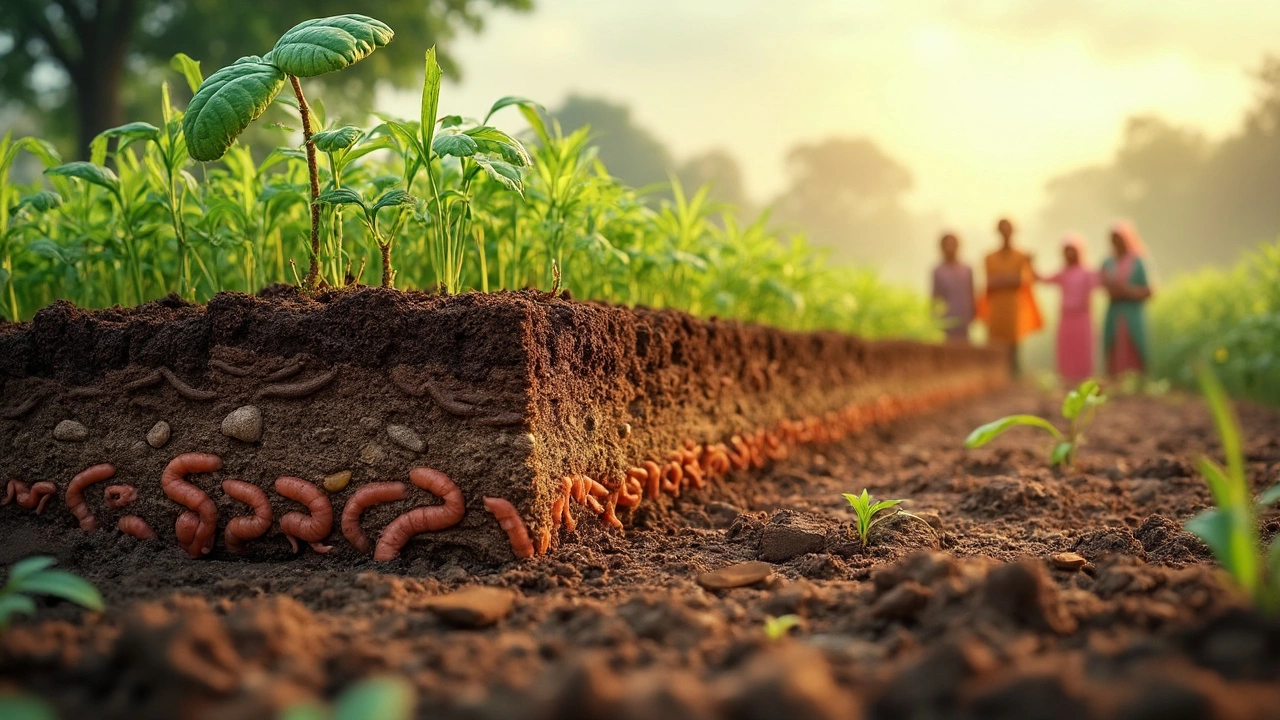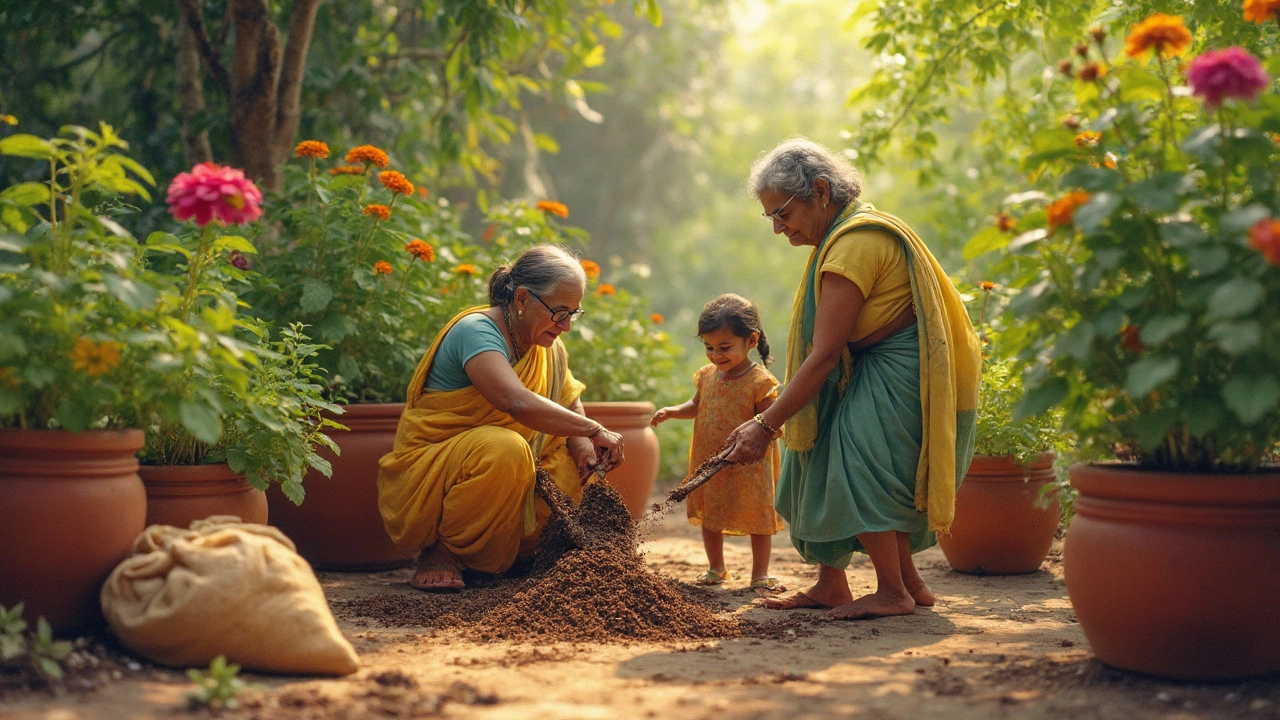Ever wondered what gives some gardeners ridiculously lush tomatoes or super-sized sunflowers without a ton of chemicals? The answer is often worm castings. These tiny pellets, left behind by hard-working earthworms, are loaded with nutrients your plants can use right away. Unlike regular compost, worm castings are gentle—there’s zero risk of burning your plant roots, so you can toss them right around seedlings or even mix into potting soil with no worries.
Here’s the cool part: worm castings don’t just feed your plants—they build up the soil too. If your garden soil is heavy and clumpy, castings help loosen it. If it’s sandy and drains too fast, they boost water retention. There’s even evidence that these castings help ward off some garden pests and diseases, making your life a lot easier.
Thinking about ways to kickstart your plants’ growth this season? Give worm castings a try—they punch way above their weight for such humble little grains. I’ll dig deeper into how they work, where they shine compared to other options, and smart ways to start using them in your own beds and pots.
- What are worm castings?
- Why do worm castings work so well?
- Tips for using worm castings in your garden
- Common mistakes and myths
What are worm castings?
If you’ve ever spotted little crumbly bits in rich garden soil, you might be looking at worm castings. They’re exactly what they sound like: the droppings of earthworms. But don't get grossed out—these are gold for your garden. When worms eat kitchen scraps or decaying plant matter, their digestive system breaks it all down into something that’s packed with nutrients and beneficial microbes. This final product is what we call worm castings, or sometimes 'vermicast.' It's basically the earthworm version of compost, but with a lot more punch.
What’s amazing is the nutrient balance inside castings. You get a little bit of everything: nitrogen, phosphorus, potassium (N-P-K), but also micronutrients like zinc, copper, and iron. These nutrients are all present in forms that plants can soak up quickly. Plus, castings are loaded with good bacteria and fungi that keep your soil lively and healthy.
Take it from Rhonda Sherman at the NC State University Vermiculture Conference, who says:
“Worm castings are a concentrated blend of beneficial microbes and nutrients that make plants healthier, more productive, and less prone to disease.”
Here’s a quick breakdown of the key nutrients commonly found in worm castings (data per pound):
| Nutrient | Amount |
|---|---|
| Total Nitrogen (N) | 1.5 - 2% |
| Available Phosphorus (P) | 1 - 1.5% |
| Potassium (K) | 0.5 - 1.2% |
| Calcium | 0.2 - 0.5% |
| Organic Matter | 40 - 55% |
Worm castings look and feel a lot like coffee grounds, but they're totally odorless. That organic matter in there helps with water holding and soil texture, especially if your garden soil is a mess. And here’s a neat tip: unlike synthetic fertilizers, castings won’t hurt your plants even if you add a lot. You don’t have to worry about root burn or toxic buildup.
If you want a soil amendment that checks every box—nutrients, soil life, safety, and easy handling—worm castings should be on your list. They’re a game-changer for everything from garden beds to houseplants.
Why do worm castings work so well?
Worm castings are like an all-in-one upgrade for your soil. First off, they pack a lot of nutrients that plants need, but in forms that roots can actually use right away. No waiting for things to break down. In fact, researchers at Ohio State University found worm castings have about five times more nitrogen, seven times more phosphorus, and over ten times more potassium than plain old topsoil. That’s a serious boost for your veggies and flowers.
Beyond just nutrients, worm castings are full of helpful microbes—basically the good bacteria that turn dead stuff into plant food and help keep bad bugs in check. These microbes improve how your soil handles water, making it easier for roots to breathe and harder for diseases to stick around. Healthier roots mean stronger, faster-growing plants.
Take a look at this quick breakdown comparing worm castings to standard compost and regular soil:
| Soil Additive | Nitrogen (N) | Phosphorus (P) | Potassium (K) | Beneficial Microbes |
|---|---|---|---|---|
| Worm Castings | High | Very High | Very High | Abundant |
| Compost | Moderate | Moderate | Moderate | Medium |
| Default Garden Soil | Low | Low | Low | Low |
Another plus—worm castings aren’t just a fertilizer. They actually improve how your soil looks and feels. They make heavy soils lighter and sandy soils more sponge-like, so water sticks around longer but doesn’t drown your plants. That’s a win in both clay-heavy backyards and raised beds that dry out too fast.
And here’s the kicker: pests like aphids and spider mites have a rougher time in gardens with castings. Some growers swear by castings for disease resistance, especially on tomatoes and leafy greens. You’ll spend less time babysitting sick plants and more time picking ripe fruit.
So, if you want all-around better plant health and a simple way to upgrade any soil, worm castings are hard to beat.

Tips for using worm castings in your garden
If you’re ready to boost your plants’ health with worm castings, there are some easy ways to get big results. The stuff is rich, so you don’t actually need a lot. Think of it as a powerful supplement instead of a replacement for all your soil or compost. Here’s how to use it best:
- Direct Top Dressing: Sprinkle worm castings right on top of the soil around your plants—about a quarter inch deep is enough. Just scratch it into the top inch of soil with your hand or a small rake, then water it in. The nutrients are released slowly, right at the roots.
- Mix Into Potting Mix: When starting seeds or filling a container, add 10–20% worm castings to your potting soil. This gives young plants a constant supply of food as they grow, which is great for strong starts.
- Make Worm Casting Tea: Take a couple handfuls of castings and soak them in a five-gallon bucket of water for 24 hours. You can pour this ‘tea’ right onto the bases of your plants or use it as a foliar spray for an extra kick. It’s especially handy for feeding delicate seedlings or plants bouncing back from stress.
- Blend Into Planting Holes: When transplanting veggies or flowers, toss a small scoop—about a half cup—of worm castings into the bottom of each hole. Your plants get an instant boost for root growth.
Worm castings work for everything from houseplants to tomatoes outside. Want specifics? Here’s a table showing average amounts to use in different garden spots:
| Plant Type | Recommended Castings/Application |
|---|---|
| Houseplants (small pot) | 2-3 tablespoons/month |
| Vegetable beds (per square foot) | 1/4 to 1/2 cup/month |
| Fruit trees (mature) | 2-3 cups, 2x/year |
| Seed starting trays | Mix 10-20% into soil |
A few quick tips: don’t worry about using too much, but honestly, a little goes a long way. Keep unused castings in a cool, dry place; if they dry out too much, you can just moisten them before using. Last thing—worm castings never smell bad (just earthy), so you can use them indoors or out without worry.
Common mistakes and myths
For something so simple, worm castings attract a lot of wild claims—and sometimes, beginner mistakes. First off, let’s clear up a myth: worm castings are not a miracle cure that can fix every garden problem in one go. They’re awesome, but your plants still need sunlight, water, and a bit of planning to thrive.
A big mistake folks make is dumping castings in huge amounts, thinking more is always better. The truth? You only need a little. Castings are super concentrated, so a light sprinkle around plants or mixing about 10-20% into your potting mix is just right. Go overboard and you’re not helping—the extra simply isn’t used up by plants.
- Worm castings are not the same as regular compost. Castings deliver a different set of nutrients and beneficial microbes, so don’t swap them out one-for-one in every situation. You’ll get the best results using both together.
- Another common myth: castings will magically get rid of all pests. They can help ward off some soil-borne nasties, but don’t expect them to scare off every bug or disease. Think of them as a helper, not a silver bullet.
- Watch out for fake products. Some bags labeled as castings are actually just compost with a dash of castings mixed in. Real castings look like fine, crumbly coffee grounds, not chunky or full of sticks.
- One more: folks sometimes assume worm castings replace fertilizer completely. While they do add nutrients and microbes, hungry plants like tomatoes might still need extra food during peak growth. Consider castings your foundation, but not the whole menu.
If you’re mixing castings into your soil, go easy and remember: quality beats quantity. Buying from a trusted source and using them right means you’ll notice healthier plants and better harvests without the guesswork. Don’t buy into the hype, just use castings as a key part of a smart gardening routine.





